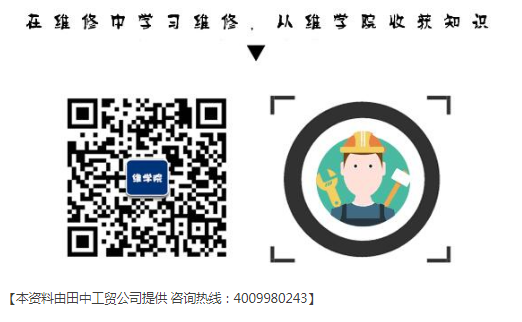01
WD615發(fā)動(dòng)機(jī)實(shí)現(xiàn)的功能
Achievable functions of WD615 engine
■ 實(shí)現(xiàn)的功能:
Achievable functions:
用于WD615發(fā)動(dòng)機(jī)的測(cè)試,檢測(cè)發(fā)動(dòng)機(jī)的機(jī)油壓力、
水溫、進(jìn)氣壓力、轉(zhuǎn)速、電瓶電壓的數(shù)值是否正常,
測(cè)試發(fā)動(dòng)機(jī)是否正常運(yùn)轉(zhuǎn),從而判斷發(fā)動(dòng)機(jī)
是否有故障,會(huì)出現(xiàn)的故障及原因分析。
For testing WD615 engine,
test whether the oil pressure, water temperature,
intake pressure, rotational speed and battery
voltage are normal, and whether the engine is
running normally, so as to determine whether
the engine has fault or not, possible fault and
analyze causes.
02
技術(shù)要求
Technical requirements
■ 主要技術(shù)參數(shù):
Main technical parameters:
① 試驗(yàn)臺(tái)架長(zhǎng)*寬*高:2950*1500*1655mm
Length *width *height of test bench:
2,950*1,500*1,655mm
② 機(jī)油壓力表數(shù)值:0-1.0Mpa
Oil pressure gauge value: 0-1.0Mpa
③ 水溫表數(shù)值:0-120°C
Water thermometer value: 0-120°C
④ 進(jìn)氣壓力表數(shù)值:0-0.1Mpa
Manifold pressure gauge value: 0-0.1Mpa
⑤ 轉(zhuǎn)速表數(shù)值:0-3000rpm
Tachometer value: 0-3,000rpm
⑥ 電瓶電壓數(shù)值:0-32V
Battery voltage value: 0-32V
03
發(fā)動(dòng)機(jī)試制前操作流程
Engine before trial-manufacture operation process
■ 用龍門(mén)吊架將發(fā)動(dòng)機(jī)吊起,把前后支撐板用螺栓
連接到發(fā)動(dòng)機(jī)上;
Lift the engine with a gantry hanger and connect
the front and rear support plate bolts to the engine.
■ 發(fā)動(dòng)機(jī)吊裝到位,用前后支撐板連接發(fā)動(dòng)機(jī)至
試驗(yàn)臺(tái)的懸置支撐架;
Lift the engine into place and connect
the engine to the test bench suspended
brace with the front and rear support plates.
■ 通過(guò)調(diào)整懸置支撐架螺桿高度,發(fā)動(dòng)機(jī)調(diào)整到位;
By adjusting the screw height of the
suspended brace, the engine is adjusted in place.
■ 使發(fā)動(dòng)機(jī)風(fēng)扇中心高度對(duì)準(zhǔn)水箱和中冷器的中心高度;
To align the center of the engine fan to the center
height of water tank and intercooling.
■ 發(fā)動(dòng)機(jī)風(fēng)扇到試驗(yàn)臺(tái)前端的中冷固定架40mm;
Engine fan to the test bench front-end
intercooled fixed mount 40mm.
■ 前支撐連接螺栓:8只M12*30
外六角螺栓 配平墊連接;
Front support connecting bolt: 8 M12*30
hexagon bolts with flat gasket connection;
■ 后支撐連接螺栓:2只M14*1.5*30
4只M14*1.5*50 外六角螺栓 配平墊和彈墊
Front support connecting bolt: 2 M14*1.5*30
4 M14*1.5*50
hexagon bolts with flat gasket and spring washer.
■ 水箱的進(jìn)出接口和中冷器進(jìn)出接口通過(guò)硅膠管
分別與發(fā)動(dòng)機(jī)進(jìn)行連接,用卡箍固定牢靠;
The inlet and outlet interface of the water tank
and the inlet and outlet interface of the intercooler
are connected to the engine respectively through
the silicone tube, and the clamp is used to fix firmly.
■ 加注完防凍液后檢查管路連接情況,
確保發(fā)動(dòng)機(jī)點(diǎn)火后能夠正常運(yùn)轉(zhuǎn),無(wú)泄漏現(xiàn)象;
After filling the antifreeze, the pipeline
connection is checked to ensure that the engine
can run normally after ignition without leakage.
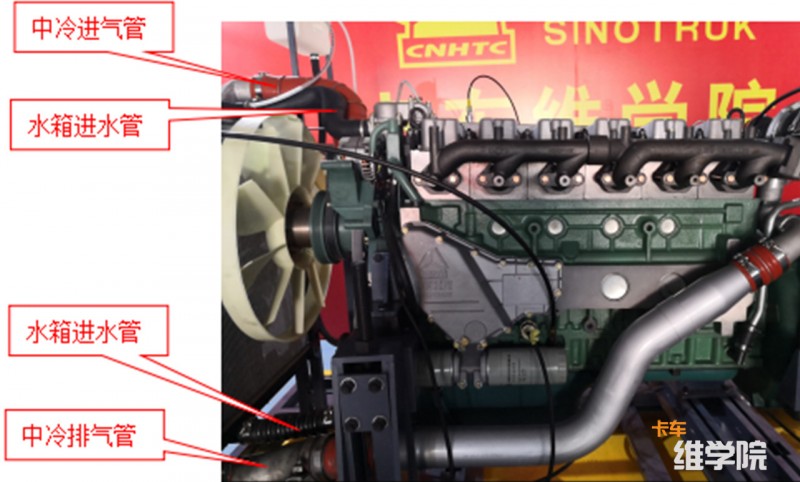
■ 連接暖風(fēng)接頭:高壓管內(nèi)徑φ22mm;
Connecting warm air joint:
Inside diameter of high-pressure pipe φ22mm.
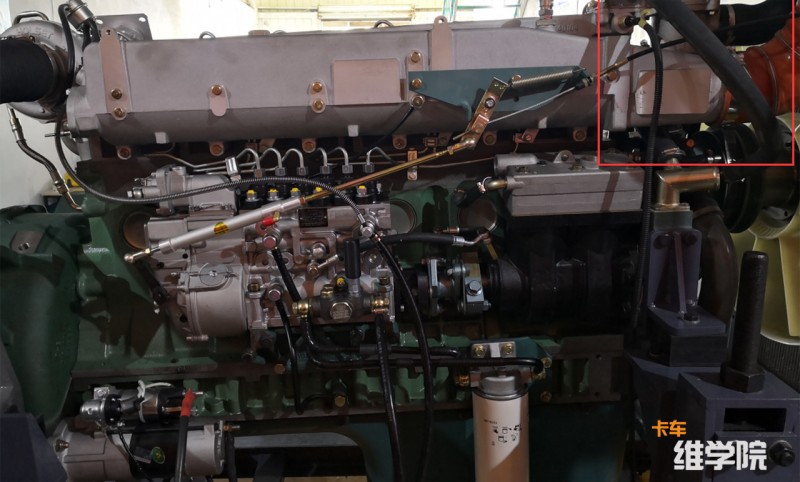
■ 連接膨脹水壺:兩根φ8mm蛇皮管,
一根接水箱小循環(huán)接頭,另一根接暖風(fēng)接頭處;
一根高壓管φ22mm接水箱出水連接管,
主要用于加注防凍液,用卡箍固定牢靠;
Connecting expansion kettle: two φ8mm
flexible conduits,
one is connected to the small circulating joint
of the water tank,
the other is connected to the warm air joint;
a high pressure pipe φ22mm is connected
to the outlet connection pipe of the water tank,
which is mainly used for filling the antifreeze;
the clamp is used to fix firmly.
■ 加注防凍液后檢查管路的連接情況,
確保發(fā)動(dòng)機(jī)點(diǎn)火后能夠正常運(yùn)轉(zhuǎn),無(wú)泄漏現(xiàn)象;
After filling the antifreeze,
the pipeline connection is checked to ensure
that the engine can run normally
after ignition without leakage.
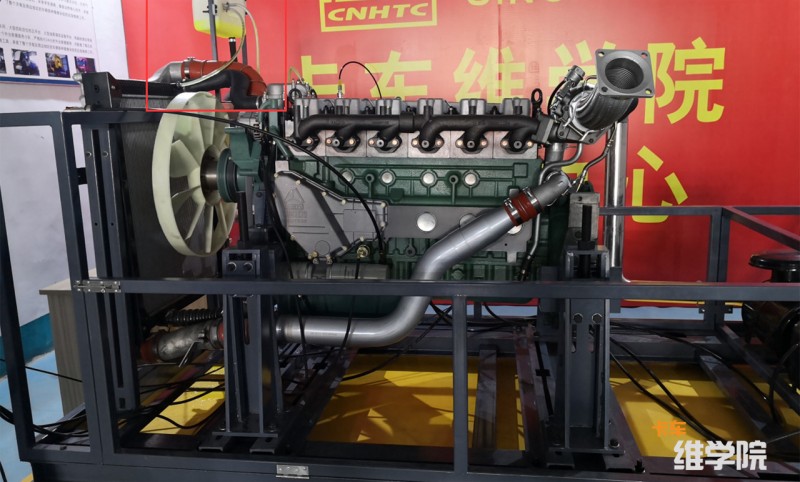
■ 連接發(fā)動(dòng)機(jī)空濾到試驗(yàn)臺(tái)的空濾總成;
Connect the engine air filter to the air filter
assembly of the test bench.
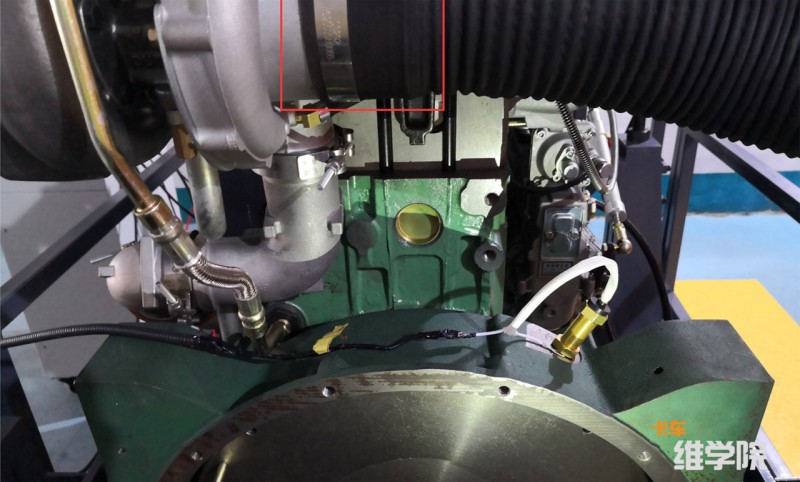
■ 渦輪增壓口排氣端到試驗(yàn)臺(tái)的排氣管,
用卡箍和固定牢靠;
Connect the exhaust end of the turbocharged
port to the exhaust pipe of the test bench
and fix firmly with a clamp.
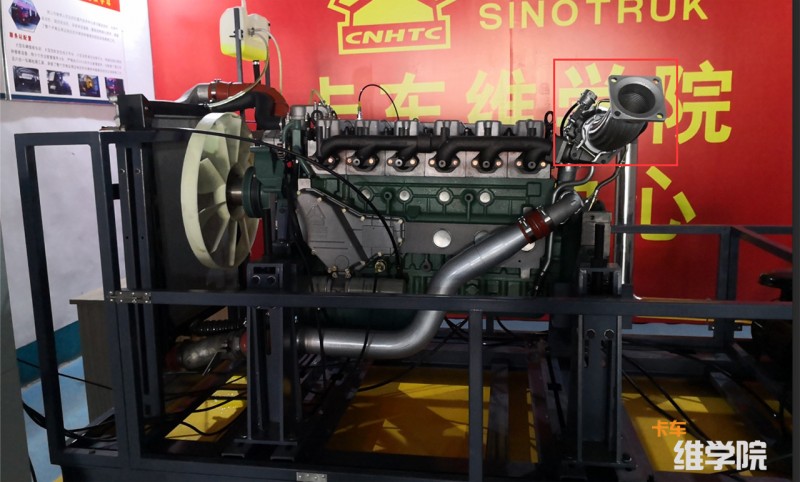
■ 連接手拉油門(mén)支架和熄火缸;
Connect hand-held throttle bracket
and flameout cylinder.
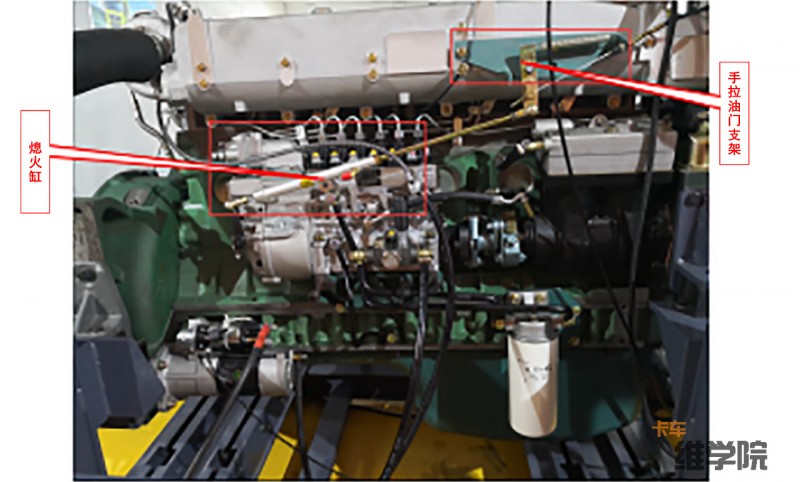
■ 連接柴油管線(xiàn),進(jìn)、回油管;
Connect diesel pipeline, inlet and return pipe.
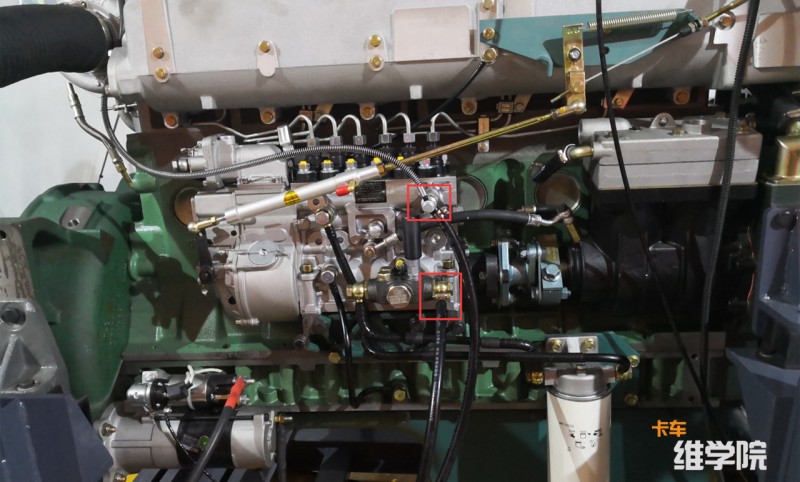
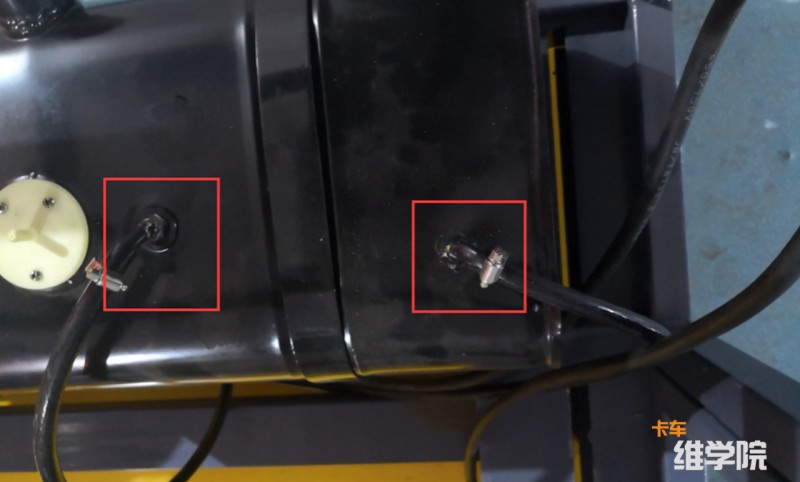
■ 連接電瓶線(xiàn)到電瓶開(kāi)關(guān)和起動(dòng)機(jī);
Connect battery cable to the battery switch
and starter.
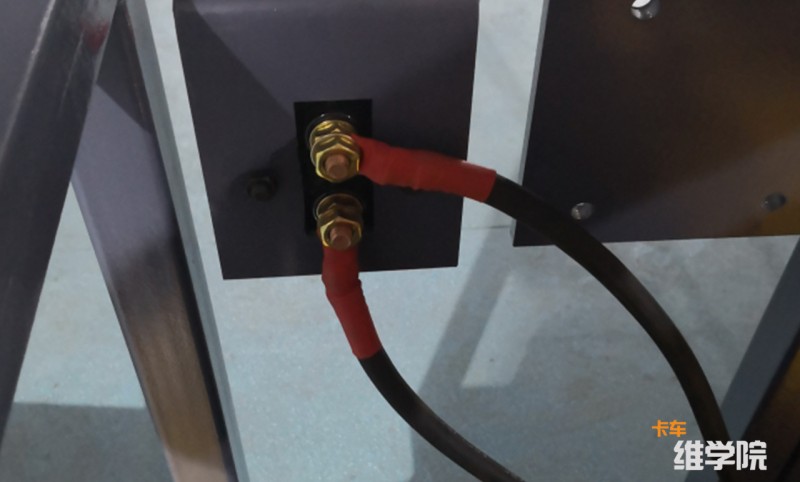
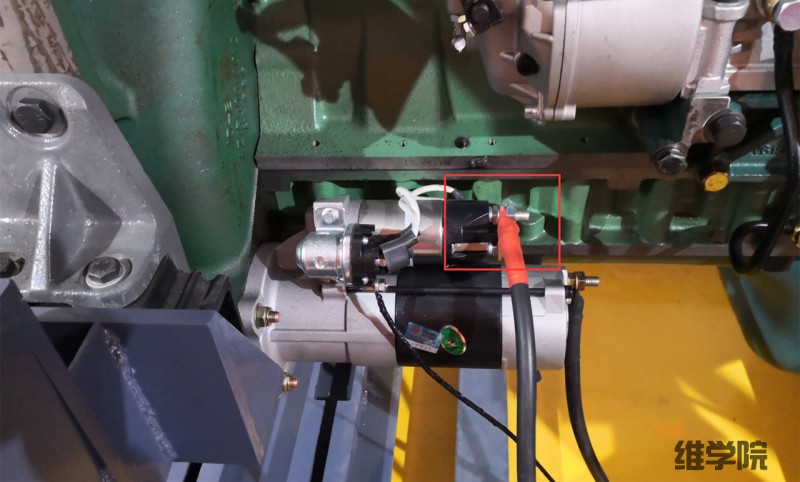
■ 連接檢測(cè)用的傳感器等其它管線(xiàn)線(xiàn)束,
將其固定牢靠位置;
Connect other pipeline harness,
such as sensors for detection,
and hold it firmly in position.
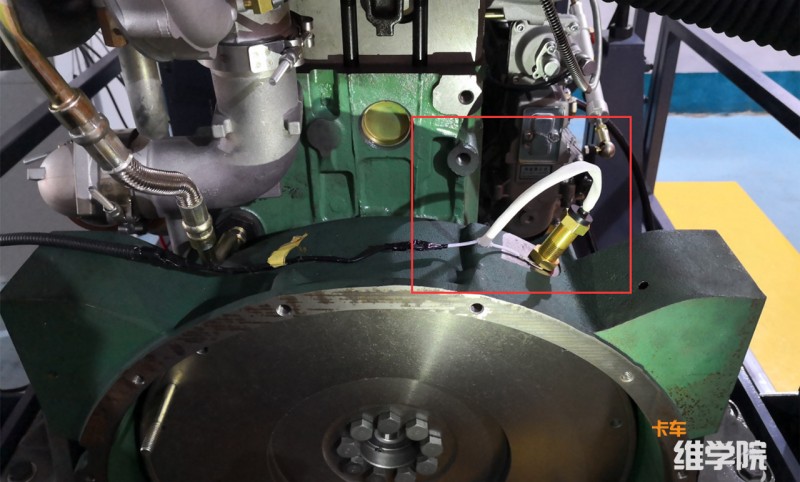
轉(zhuǎn)速傳感器及線(xiàn)束
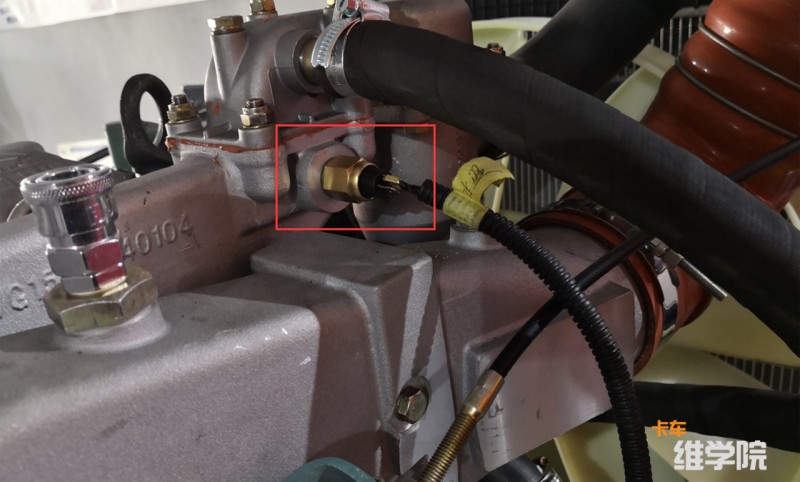
水溫傳感器及線(xiàn)束
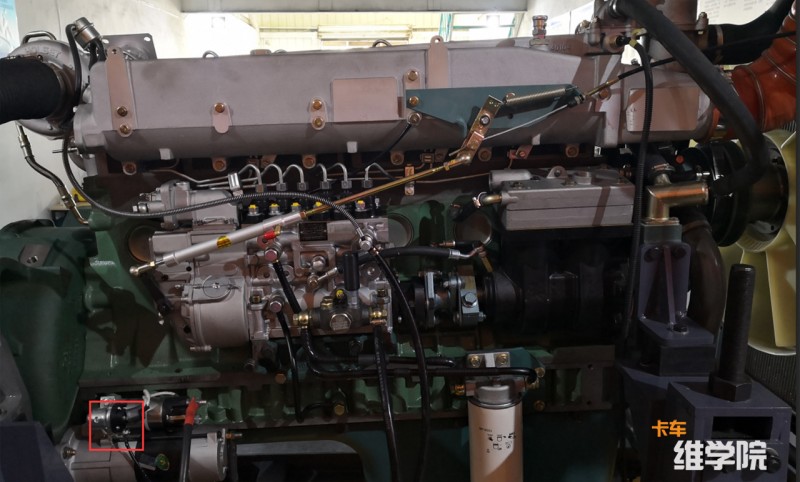
電瓶電壓線(xiàn)束直接接起動(dòng)機(jī)
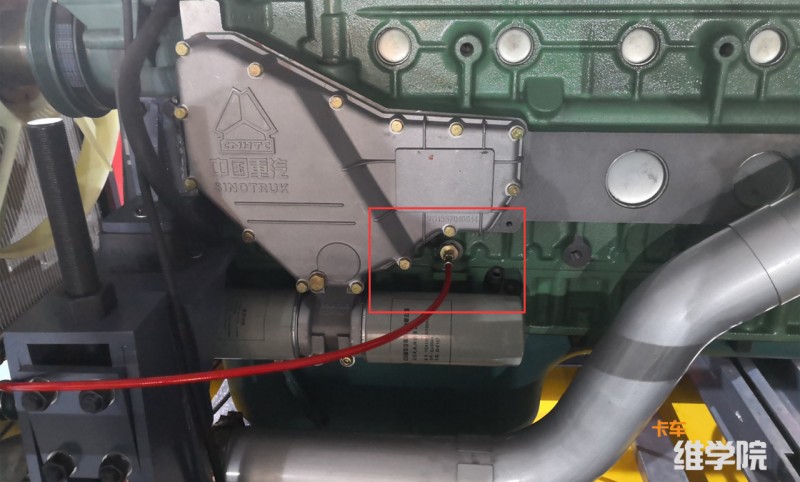
機(jī)油壓力線(xiàn)束及接頭
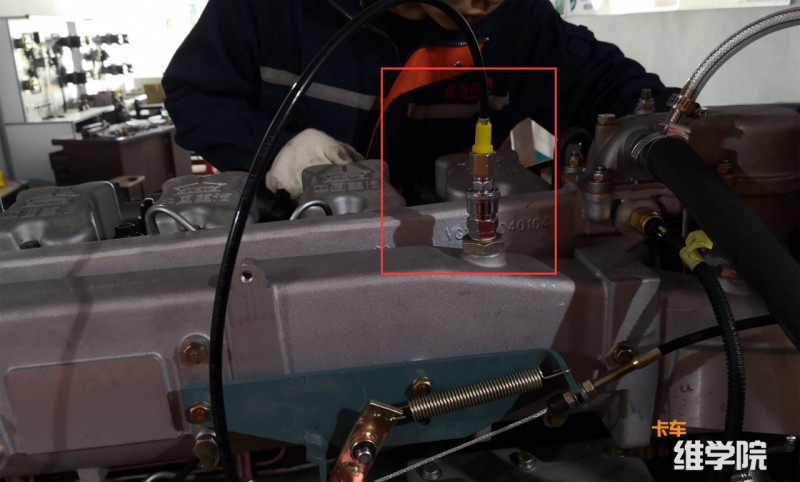
進(jìn)氣壓力線(xiàn)束及接頭
■ 連接控制臺(tái)手拉油門(mén)拉線(xiàn)至支架和熄火缸;
檢查管線(xiàn)的連接,確保連接牢靠、無(wú)誤。
Connect the hand-held throttle stay of
control panel to the bracket and flameout cylinder;
Finally, check the pipeline connection to ensure
that the connection is reliable and correct.
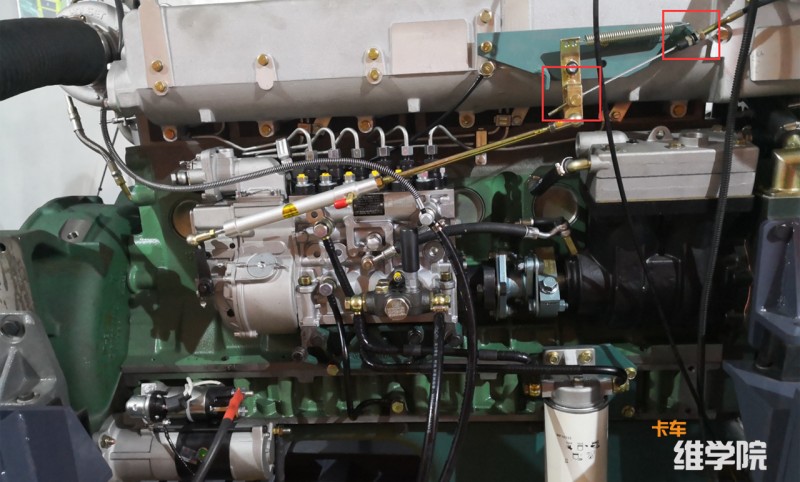
04
發(fā)動(dòng)機(jī)性能驗(yàn)證操作流程
Operation process of engine performance verification
■ 打開(kāi)點(diǎn)火鑰匙開(kāi)關(guān),電瓶電壓表顯示24V;
Turn on the ignition key switch,
the battery voltage meter displays 24V.
■ 通過(guò)控制手拉油門(mén)大小,實(shí)現(xiàn)發(fā)動(dòng)機(jī)的不同轉(zhuǎn)速;
By controlling the hand-held throttle,
the different rotational speeds
of the engine can be realized.
■ 分別讀取控制臺(tái)上的儀表數(shù)值,
與整車(chē)上的參考值對(duì)比:檢測(cè)發(fā)動(dòng)機(jī)的運(yùn)轉(zhuǎn)情況,
可讀取的數(shù)值機(jī)油壓力、水溫、進(jìn)氣壓力、
發(fā)動(dòng)機(jī)轉(zhuǎn)速、電瓶電壓。
Read the meter value on the control panel,
respectively, and compare with the reference value
on the vehicle: Test engine operation, readable
numerical oil pressure, water temperature, intake
pressure, engine rotational speed and battery
voltage.
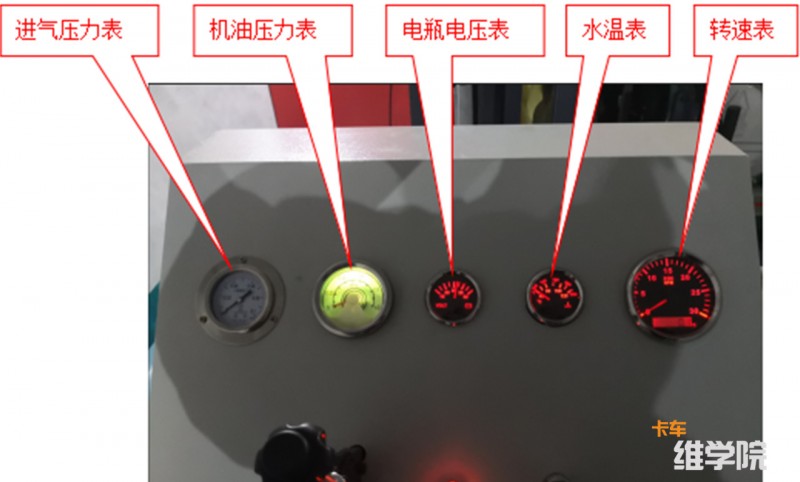
① 轉(zhuǎn)速600rpm時(shí):機(jī)油壓力0.5mpa。【怠速】
Rotational speed 600rpm:
Oil pressure 0.5mpa [idle speed]
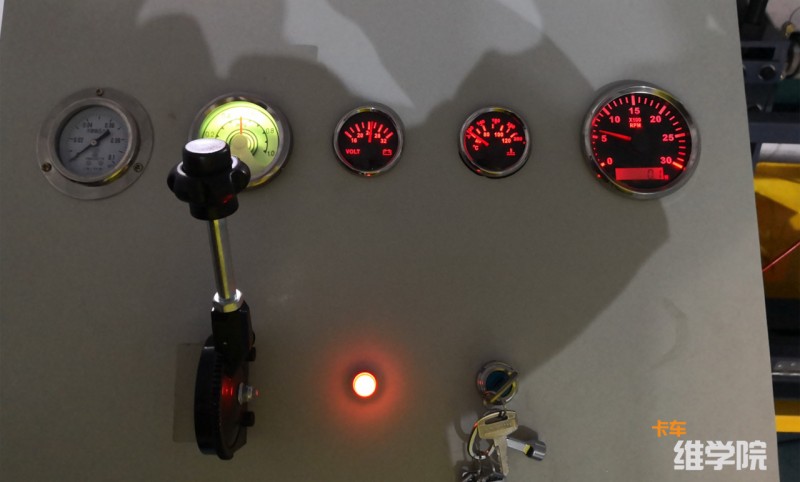
② 轉(zhuǎn)速1000rpm時(shí):機(jī)油壓力0.6mpa。
Rotational speed 1,000rpm:
Oil pressure 0.6mpa
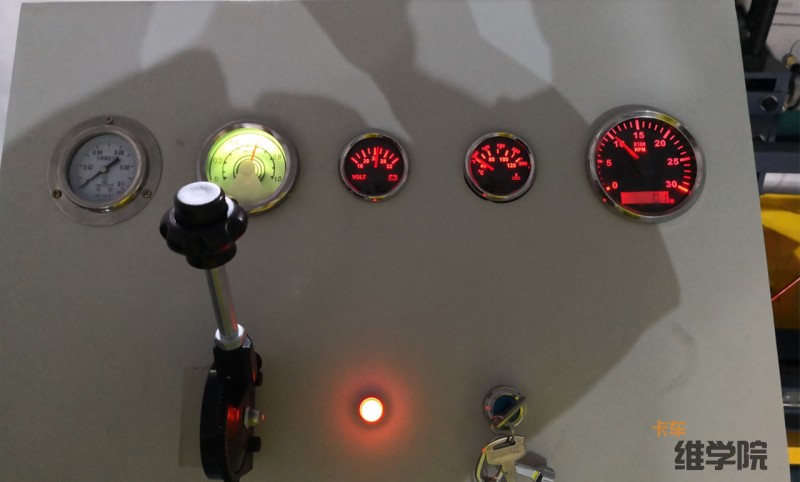
③ 轉(zhuǎn)速1500rpm時(shí):機(jī)油壓力0.6mpa,
進(jìn)氣壓力0.01mpa。
Rotational speed 1,500rpm,
oil pressure 0.6mpa,
intake pressure 0.01mpa
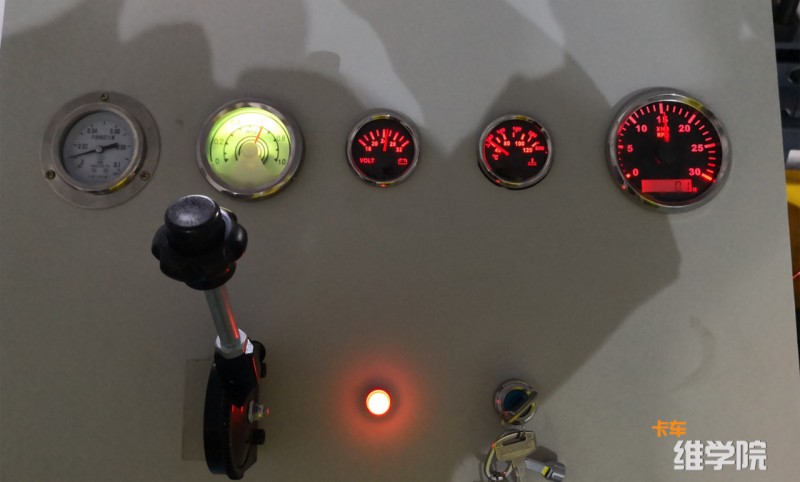
④ 轉(zhuǎn)速2000rpm時(shí):機(jī)油壓力0.65mpa,
進(jìn)氣壓力0.02mpa。
Rotational speed 2,000rpm,
oil pressure 0.65mpa,
intake pressure 0.02mpa
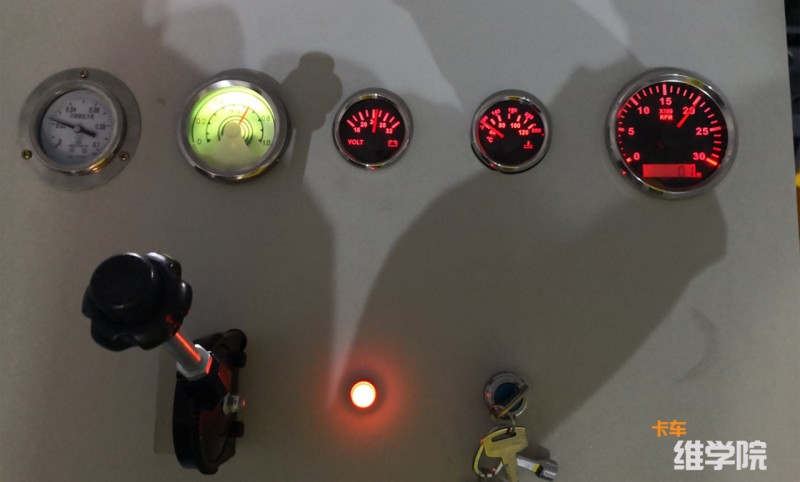
⑤ 在發(fā)動(dòng)機(jī)運(yùn)轉(zhuǎn)30分鐘后,水溫表顯示數(shù)值約50℃。
After the engine has been running for 30 minutes,
the water thermometer shows about 50 ℃
■ 松開(kāi)手拉油門(mén),關(guān)閉點(diǎn)火鑰匙,發(fā)動(dòng)機(jī)停止運(yùn)轉(zhuǎn),
將發(fā)動(dòng)機(jī)吊裝下來(lái),發(fā)動(dòng)機(jī)測(cè)試完畢。
Release the hand-held throttle,
turn off the ignition key,
stop the engine from running,
lift the engine down,
and finish the engine test.
05
原理故障表
Principle fault list
A. 在點(diǎn)火后通過(guò)控制臺(tái)上的儀表數(shù)值的大小,
判斷被檢測(cè)的發(fā)動(dòng)機(jī)的運(yùn)轉(zhuǎn)是否正常。
Determine whether the tested engine is running
properly or not through the size of the meter
value on the control panel after ignition.
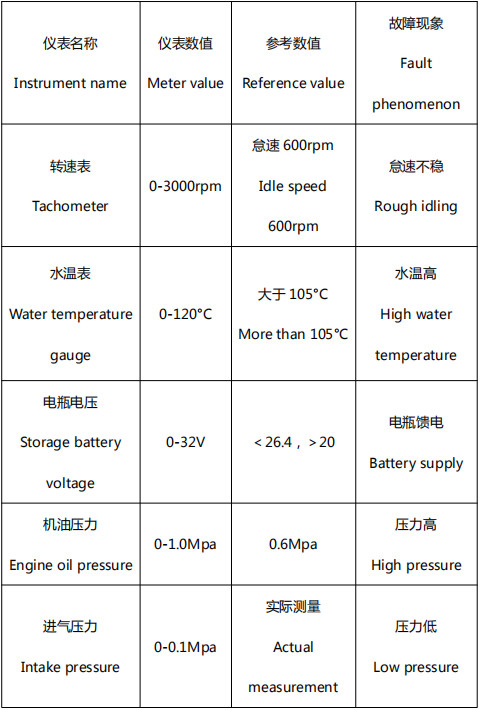
B. 故障分析:
Fault Analysis:
1. 怠速不穩(wěn)的原因:
Reason of rough idling
① 進(jìn)氣系統(tǒng)。
Intake system
第一個(gè)原因是進(jìn)氣系統(tǒng),進(jìn)氣管以及各種閥門(mén)的泄漏。
空氣或者是從進(jìn)氣管進(jìn)入,還有廢氣進(jìn)入到進(jìn)氣管,
會(huì)造成混合器過(guò)濃、過(guò)稀,使發(fā)動(dòng)機(jī)燃燒不正常。
節(jié)氣門(mén)和進(jìn)氣道積垢過(guò)多。怠速進(jìn)氣量的失準(zhǔn)。
The first reason is the leakage of the intake system,
intake pipe and various valves.
Air enters from the intake pipe and exhaust gas
entering into the intake pipe will cause the mixer
to be too dense and too thin, causing the engine
to burn abnormally. There is excessive fouling on
the throttle and air inlet. Misalignment of
idle air inflow.
② 燃油系統(tǒng)。
Fuel system
若大泵有滴漏或堵塞現(xiàn)象,使其無(wú)法過(guò)油,
從而造成混合氣過(guò)濃或過(guò)稀,使個(gè)別氣缸工作不良,
導(dǎo)致發(fā)動(dòng)機(jī)怠速不穩(wěn)。燃油壓力故障。油壓過(guò)低,
噴油量減少使混合氣過(guò)稀;油壓過(guò)高,
實(shí)際噴油量增加,使混合氣過(guò)濃。噴油量失準(zhǔn)。
If the large pump has dripping or
blocking phenomenon, it cannot filter the oil,
resulting in the mixture is too dense or too thin,
which makes individual cylinders work poorly and
leads to unstable engine idle speed.
Fuel pressure fault. When the oil pressure is too
low, the mixture becomes too thin due to the
decrease of fuel-injection quantity; When the oil
pressure is too high, the actual fuel-injection
quantity increases, which causes too thick mixture.
Misalignment of fuel-injection quantity.
③ 機(jī)械機(jī)構(gòu)。
Mechanical structure
第一是配氣機(jī)構(gòu),配氣機(jī)構(gòu)故障導(dǎo)致個(gè)別氣缸的功率
下降過(guò)多,從而使功率不平衡。
第二是氣門(mén)工作面與氣門(mén)座圈積碳過(guò)多,
造成氣門(mén)密封不嚴(yán)。
第三是發(fā)動(dòng)體和活塞連桿機(jī)構(gòu),
它有故障也會(huì)使壓縮壓力不一致。
The first is the valve actuating mechanism,
the failure of valve actuating mechanism
causes the power of individual cylinders to
decrease too much and the power is unbalanced.
The second is valve face and valve retainer
have too much carbon deposit, causing valve seal
is not firm. The third is the actuator and
piston-connecting rod mechanism,
which may cause the compression
pressure to be inconsistent with faults.
④ 排氣系統(tǒng)堵塞。
Exhaust system blocking
與三元催化器內(nèi)因部因結(jié)膠、積炭、破碎等原因
造成局部堵塞或隨機(jī)堵塞,就加大排氣時(shí)的反壓力,
使進(jìn)氣管真空度過(guò)低,造成發(fā)動(dòng)機(jī)排氣不徹底、
進(jìn)氣不充分,氣缸性能變差。發(fā)動(dòng)機(jī)怠速發(fā)抖。
進(jìn)氣不順暢可能造成電腦記憶空氣流量計(jì)故障代碼。
若該故障長(zhǎng)時(shí)間不排除,將使氧傳感器長(zhǎng)期在
惡劣條件下工作,加速了氧傳感器的損壞,
造成發(fā)動(dòng)機(jī)故障燈亮。
When the three-way catalyst causes local or
random blocking due to gumming, carbon
deposition and fragmentation, it will increase
the back pressure of exhaust gas, make the intake
pipe vacuum too low, and cause the engine exhaust
gas to be incomplete and the intake air not
sufficient. As a result, the working performance of
the cylinder becomes worse. Engine idle trembling.
Air intake problems may also cause computer
memory air flow meter fault code. If the fault is not
ruled out for a long time, it will make the oxygen
sensor workingin harsh conditions for a long time,
accelerate the damage of the oxygen sensor, and
cause the engine fault light to turn on.
2. 水溫高的原因:
Reason of high-water temperature
① 水箱缺水。
Water tank water depletion
發(fā)動(dòng)機(jī)是通過(guò)水冷的方式來(lái)降溫,雖然水箱里的
冷卻液消耗的比較慢,但是也有消耗,
有些車(chē)主沒(méi)有檢查冷卻液的習(xí)慣,
水箱長(zhǎng)時(shí)間缺水,導(dǎo)致水溫高。
The engine is cooled by water cooling, although
the coolant consumption in the water tank is slow,
there is also consumption. Some owners do not
check the coolant, the water tank is short of water
for a long time, resulting in high water temperature.
② 節(jié)溫器故障。
Thermostat fault
有些車(chē)主開(kāi)車(chē)沒(méi)走幾公里就發(fā)現(xiàn)水溫升高,
也沒(méi)有發(fā)現(xiàn)哪個(gè)水管有漏水的地方,
像這種故障可能是節(jié)溫器打不開(kāi),
汽車(chē)?yán)鋮s系統(tǒng)不能進(jìn)行大循環(huán),導(dǎo)致水溫高。
Some car owners find that the water temperature
rise after driving a few kilometers, and there was
no leak in the water pipe. This kind of fault may
be that thermostat cannot be opened, the car
cooling system cannot carry on a general
circulation, resulting in high water temperature.
③ 水管漏水。
Water pipe leakage
開(kāi)車(chē)過(guò)程中發(fā)現(xiàn)汽車(chē)有漏水的地方,
檢查是水管老化、破裂漏水,
這種情況相對(duì)來(lái)說(shuō)容易發(fā)現(xiàn),
到維修店更換相應(yīng)的水管即可。
In the course of driving, if finding out where
the car has water leakages, check the water
pipe aging and breakage. It is easy to find it,
and you can replace the corresponding water
pipe at the maintenance shop.
④ 水箱散熱不良。
Bad water tank heat dissipation
有些車(chē)主直接用水當(dāng)作冷卻液,
長(zhǎng)時(shí)間使用水做媒體會(huì)導(dǎo)致發(fā)動(dòng)機(jī)及水箱內(nèi)產(chǎn)生水銹,
水箱散熱不良導(dǎo)致水溫高,
想要解決這種辦法是把水銹先排除,
然后清洗或更換水箱。
Some car owners directly use water as coolant.
Long-term use of water as the media will lead
to water rust in the engine and water tank, the
bad heat dissipation of the water tank leads to
high water temperature. Solving this problem is
to remove the rust first, then clean or replace
the water tank.
⑤ 水泵故障。
Water pump fault
水泵是汽車(chē)?yán)鋮s系統(tǒng)的核心,現(xiàn)在汽車(chē)用的水泵
大多數(shù)是葉片式的,長(zhǎng)時(shí)間泵水后葉片會(huì)打磨掉,
水系統(tǒng)不循環(huán)水溫高。
The water pump is the core part of cooling system
in the car. Now most of the water pumps used in
car are blade-type. After working for a long time,
the blades will be polished away, which will cause
the water system does not circulate and the water
temperature is high.
⑥ 缸床墊變形。
Cylinder mattress is deformed
有些車(chē)主反應(yīng)汽車(chē)水溫高,但在實(shí)際用車(chē)過(guò)程中
并沒(méi)有發(fā)現(xiàn)有漏水的地方,另外水箱內(nèi)的冷卻液
消耗的比較快,這種情況是發(fā)動(dòng)機(jī)缸床墊變形或
破損導(dǎo)致少量冷卻水進(jìn)入發(fā)動(dòng)機(jī)燃燒,
所以會(huì)出現(xiàn)汽車(chē)行駛一段時(shí)間后水箱缺水,水溫高。
Some car owners reacted to the high water
temperature of the car, but actually there was
no water leakage when using the car. In addition,
a small amount of cooling water enters into the
engine due to deformation or damage of the
engine cylinder mattress. In this situation, the
coolant in the tank was consumed more quickly,
so there will be a water shortage in the water
tank after the car has been running for a while
and the water temperature is high.
⑦ 電子扇故障。
Electronic fan failure
汽車(chē)水箱內(nèi)的熱量通過(guò)電子風(fēng)扇轉(zhuǎn)動(dòng)來(lái)散發(fā)出來(lái),
如果電子扇不工作熱量散不掉,汽車(chē)水溫肯定會(huì)升高。
The heat from water tank on the car is emitted by
the rotation of the electronic fan. If the electric fan
does not work, the water temperature of the car will
definitely rise.
⑧ 傳感器故障。
Sensor fault
汽車(chē)上的水溫傳感器控制水箱電子風(fēng)扇的運(yùn)轉(zhuǎn),
如果水溫傳感器有故障,沒(méi)有信號(hào)啟動(dòng)散熱風(fēng)扇,
水溫也會(huì)升高。
The water temperature sensor on the car controls
the operation of the electronic fan in water tank.
If the water temperature sensor is faulty and there
is no signal to activate the cooling fan, the water
temperature will be rose.
⑨ 線(xiàn)束故障。
Harness fault
汽車(chē)上的線(xiàn)束是整個(gè)汽車(chē)的神經(jīng),
如果線(xiàn)路有故障也會(huì)間接導(dǎo)致水溫高。
The harness on the car is the core part
of the whole car. If the line is faulty,
it will indirectly lead to high water temperature.
3. 電壓低的原因:
Reason for low voltage:
① 第一種導(dǎo)致汽車(chē)電瓶電壓過(guò)低情況的發(fā)生的原因
就是長(zhǎng)期的閑置汽車(chē),因?yàn)槠?chē)電瓶?jī)?nèi)部構(gòu)造、比重、
溫度、物質(zhì)不純的原因,電瓶往往會(huì)發(fā)生自放電,
一般在一天內(nèi)會(huì)放掉0.5~1%電量,
如果汽車(chē)長(zhǎng)期的閑置不用,就容易導(dǎo)致電瓶放電過(guò)度,
無(wú)法繼續(xù)充電使用情況的發(fā)生。
The long-term idle car is the first reason to cause
the low voltage of car battery. Because of the
internal structure, specific gravity, temperature
and material impureness of the car battery, the
battery will often self-discharge, and will usually
be discharged 0.5~1% of electricity in one day.
If the car is not used for a long time, it will easily
lead to excessive battery discharge and be unable
to continue charging.
② 現(xiàn)如今,普通的汽車(chē)電瓶一般都采用的貧液式設(shè)計(jì),
電解液里面的水分通常也會(huì)自然而然的漸漸揮發(fā),
會(huì)逐漸形成白色硫酸鉛化,在汽車(chē)電瓶?jī)?nèi)部極板嚴(yán)重
硫酸鉛化后,再想要去充電、補(bǔ)水也是不行的,
是無(wú)法恢復(fù)其容量的。
Nowadays, ordinary car batteries generally was
designed as lean liquid type. The moisture in the
electrolyte will be gradually volatilized, and white
lead sulfate will be gradually formed. After the
internal electrode of the car battery is severely
sulfated, recharging the battery cannot restore
its capacity, and hydration is also not enough.
③ 由于汽車(chē)電瓶?jī)?nèi)部是純化學(xué)反應(yīng),它主要利用原理是,
將電能儲(chǔ)存成化學(xué)能儲(chǔ)存,在需要使用放電的時(shí)候,
將化學(xué)能轉(zhuǎn)換成電能,因此由于技術(shù)的原因電瓶本身
也是有壽命限制的,一般的電瓶本身壽命基本也只是
在充放電300次,當(dāng)使用壽命差不多的時(shí)候,
就會(huì)出現(xiàn)電壓過(guò)低的情況了。
Since the interior of the car battery is a purely
chemical reaction, its main principle is to store
electrical energy into chemical energy storage.
When the discharge is required, the chemical
energy is converted into electrical energy.
Therefore, the battery has a service life limit due
to technical problems. The service life of a typical
battery is basically only 300 times of charging
and discharging. When the service life is
almost the same, the voltage will be too low.
4. 機(jī)油壓力高的原因:
Reasons for high oil pressure
① 機(jī)油粘度過(guò)大。
Oil viscosity is too large
機(jī)油粘度的大小表明了機(jī)油流動(dòng)時(shí)的內(nèi)摩擦阻力大小。
機(jī)油粘度的大小與發(fā)動(dòng)機(jī)溫度有關(guān),發(fā)動(dòng)機(jī)溫度低時(shí),
機(jī)油粘度大;反之,發(fā)動(dòng)機(jī)溫度高時(shí),機(jī)油粘度小。
機(jī)油粘度大時(shí)流動(dòng)性差但密封性好,泄漏量少。
如果機(jī)油粘度超過(guò)規(guī)定值,機(jī)油在潤(rùn)滑系統(tǒng)內(nèi)流動(dòng)
阻力會(huì)增大,同時(shí)壓力升高。發(fā)動(dòng)機(jī)溫度低或機(jī)油
本身粘度大(因?qū)C(jī)油牌號(hào)選用不當(dāng),即機(jī)油牌號(hào)
不適合環(huán)境溫度,如冬季選用了夏季粘度大的機(jī)油)
機(jī)油壓力會(huì)高。
The oil viscosity indicates the amount of internal
friction resistance when the oil flows. The oil
viscosity is related to the engine temperature.
When the engine temperature is low, the viscosity
of the oil is large. Conversely, when the engine
temperature is high, the oil viscosity is small. When
oil viscosity is large, the fluidity is poor, but the
leakproof is good, and the leakage amount is small.
If the oil viscosity exceeds the specified value,
the flow resistance of the oil in the lubrication
system will be increased. At the same, the pressure
will be increased. This shows that the engine
temperature is low or the oil viscosity is large,
the oil pressure will be high. Because the oil grade
is not properly selected, that is the oil grade is not
suitable for the ambient temperature. For example,
the large oil viscosity for summer is selected
in winter.
② 壓力潤(rùn)滑部位間隙過(guò)小或機(jī)油細(xì)濾器堵塞潤(rùn)滑油路。
The gap of pressure lubrication part is too small
or the oil fine filter block the lubricating oil to flow.
潤(rùn)滑系機(jī)油循環(huán)回路的流動(dòng)阻力等于并聯(lián)支路機(jī)油
流動(dòng)阻力的倒數(shù)之和。壓力潤(rùn)滑部位的凸輪軸軸頸、
連桿軸頸、曲軸軸頸、搖臂軸等,這些潤(rùn)滑部位
如果配合間隙過(guò)小,細(xì)濾清器的濾芯過(guò)臟使機(jī)油
回路堵塞,以及限壓閥調(diào)整壓力過(guò)高等,
均會(huì)使?jié)櫥涤吐返牧鲃?dòng)阻力增大,壓力升高。
It shows that the flow resistance of the lubricating
oil circulation circuit is equal to the sum of the
reciprocal of the parallel branch oil flow resistance.
If the matching clearance of the camshaft journal,
the connecting rod journal, the crankshaft journal
and the rocker shaft on the pressure lubrication
part is too small and the filter element of the fine
filter is dirty, the oil circuit will be blocked. And if
the pressure of the pressure limiting valve is
adjusted too high, the flow resistance of the
lubricating oil circuit will be increased and the
pressure will be increased.
③ 限壓閥調(diào)整不當(dāng)。
The pressure of the pressure limiting
valve is adjusted improperly
由限壓閥組成和工作原理可知,限壓閥是靠平衡彈簧
和球閥來(lái)限制機(jī)油壓力的,并使之機(jī)油壓力不超過(guò)
技術(shù)文件的規(guī)定值。機(jī)油壓力超過(guò)規(guī)定值時(shí),
便克服彈簧的彈力將閥門(mén)推開(kāi)向系統(tǒng)內(nèi)泄壓,
機(jī)油壓力低于彈簧彈力時(shí),閥門(mén)在彈簧的作用下關(guān)閉,
從而將壓力限制在規(guī)定的范圍內(nèi)。潤(rùn)滑系的機(jī)油壓力
取決于彈簧彈力的大小,如果調(diào)整的彈簧彈力過(guò)大,
會(huì)使系統(tǒng)內(nèi)的機(jī)油壓力過(guò)高。
According to the composition and working principle
of the pressure limiting valve, the pressure limiting
valve relies on the balance spring and the ball valve
to limit the oil pressure, and the oil pressure does
not exceed the specified value of the technical
documents. When the oil pressure exceeds the
specified value, the valve is pushed away from the
spring by the spring force of spring to relieve
pressure in the system. When the oil pressure is
lower than the spring force, the valve is closed with
the action of the spring to limit the pressure within
the specified range. From this point of view,
the oil pressure in the lubrication system depends
on the spring force of the spring. If the adjusted
spring force is too large, the oil pressure in the
system will be too large.
④ 機(jī)油濾清器堵塞。
Engine oil filter is blocked
當(dāng)機(jī)油濾清器堵塞而不能流通時(shí),設(shè)在濾清器底座
上的安全閥就被頂開(kāi),機(jī)油便不經(jīng)過(guò)濾而直接
進(jìn)入主油道。如果安全閥的開(kāi)啟壓力調(diào)的過(guò)高,
當(dāng)濾清器被堵塞時(shí)就不能及時(shí)頂開(kāi),機(jī)油泵壓力升高,
內(nèi)漏增加,對(duì)主油道的供油量相應(yīng)減少,
引起油壓的下降。應(yīng)經(jīng)常保持機(jī)油濾清器的清潔;
正確地調(diào)整安全閥的開(kāi)啟壓力(一般為0.35-0.45Mpa);
及時(shí)更換安全閥的彈簧或研磨鋼珠與閥座的配合面,
恢復(fù)其正常的工作性能。
When the oil filter is clogged and the oil cannot be
flowed, the safety valve installed on the filter base
is opened and the oil will directly flow into the main
oil passage without filtering. If the opening
pressure of the safety valve is too large, it cannot
be opened in time when the filter is blocked.
Therefore,if the pressure of the oil pump is
increased, the internal leakage will be increased,
and the oil supply to the main oil passage is
correspondingly reduced, which will decline oil
pressure. It should be always kept the oil filter
clean; Adjust the opening pressure of the
safety valve correctly (it is generally 0.35-0.45Mpa);
Replace the spring of the safety valve or the mating
surface of the grinding steel ball with the valve seat
in time to restore its normal working performance.
5. 進(jìn)氣壓力低的原因:
Reasons for low intake pressure
① 空氣需求量大于供給量。
Air demand is greater than supply
檢查供氣管道上的閥門(mén)是否開(kāi)啟或系統(tǒng)上是否
有漏氣現(xiàn)象,減少用氣量。
Check if the valve on the air supply pipe is open
or not, if there is air leakage on the system or not,
which reduce the air consumption.
② 油氣分離器堵塞。
Oil and gas separator is blocked
由于油路系統(tǒng)中或多或少存在某些雜質(zhì),
濾芯工作一段時(shí)間后,會(huì)發(fā)生阻塞現(xiàn)象使壓縮空氣
通過(guò)濾芯的阻力增加,影響機(jī)組的正常工作。
操作人員根據(jù)監(jiān)控器面板上的信號(hào),及時(shí)更換濾芯。
Due to more or less impurities in the oil system,
the filter element will be blocked after it is operated
for a period of time, which will increase the
resistance of the compressed air through the filter
element and affect the normal operation.
Therefore, the operator should replace the filter
element in time according tothe signal displayed
on the monitor panel.
③ 空氣過(guò)濾器堵塞。
Air filter is clogged
空氣濾清器的作用是將吸入的空氣加以過(guò)濾,
保證進(jìn)入空氣壓縮機(jī)的空氣清潔干凈。
如果空氣過(guò)濾器濾芯堵塞嚴(yán)重將影響到
機(jī)組的進(jìn)氣量。所以必須及時(shí)更換其濾芯。
The air filter is to filter the inhaled air to ensure
that the air entering into the air compressor is
clean. If the air filter element is clogged, it will
affect the intake air volume of the machine.
Therefore, it is necessary to replace its filter
element in time.
④ 壓力調(diào)節(jié)器失靈或損壞。
Pressure regulator is malfunctioned or damaged
壓力調(diào)節(jié)系統(tǒng)的功能是根據(jù)客戶(hù)用氣量的大小,
自動(dòng)調(diào)節(jié)壓縮機(jī),以便達(dá)到供需平衡。
所以要對(duì)損壞的壓力調(diào)節(jié)器及時(shí)更換,
對(duì)失靈的壓力調(diào)節(jié)器及時(shí)調(diào)整。
The pressure regulation system is to automatically
adjust the compressor according to the amount of
gas used by the customer in order to achieve a
alance between supply and demand. Therefore,
it is necessary to replace the damaged pressure
regulator in time, and adjust the malfunctioning
pressure regulator in time.
⑤ 進(jìn)氣閥不能完全打開(kāi)。
Air intake valve is not fully open
進(jìn)氣閥的功能是控制進(jìn)氣量。機(jī)組滿(mǎn)負(fù)荷運(yùn)行時(shí),
進(jìn)氣閥處于全開(kāi)狀態(tài)。當(dāng)用戶(hù)所需用氣量減小時(shí),
由氣量調(diào)節(jié)裝置向進(jìn)氣閥輸入壓縮空氣,
使進(jìn)氣閥開(kāi)度減小,從而減少壓縮機(jī)的進(jìn)氣量,
進(jìn)氣閥故障將影響機(jī)組所帶負(fù)荷的多少。
The intake valve is to control the amount of intake
air. When the machine is running at full load,
the intake valve is fully open. When the amount of
gas required by the user is reduced, the device of
air volume adjusting will input compressed air to
the intake valve to reduce the opening degree of
the intake valve, which will reduce the intake air
amount of the compressor. The Intake valve
failure will affect the load on the unit.
⑥ 控制管路漏氣。
Control line is leaked.
空氣壓縮機(jī)控制管路漏氣將使進(jìn)氣閥無(wú)法
全部打開(kāi)以至于機(jī)組負(fù)荷無(wú)法帶滿(mǎn)。
Air leakage from the air compressor control line
will prevent the intake valve from opening
completely so that the unit load cannot be
fully loaded.
